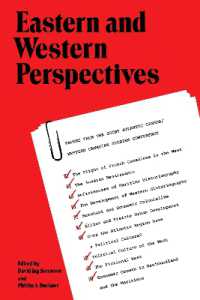- ホーム
- > 洋書
- > 英文書
- > Science / Mathematics
Full Description
Nitrogen Heterocycles in Cancer Therapy explores the vast array of recently discovered nitrogen-containing heterocyclic compounds utilized in combatting cancer. This comprehensive work not only highlights the fundamentals of oncology but also explains into the intricacies of designing, synthesizing, and understanding the anticancer mechanisms of these compounds. Spanning across 10 chapters, the book explores the principles underlying the design, synthesis, and anticancer mechanisms of nitrogen-containing heterocyclic compounds, drawing from the latest research findings. Its scope extends beyond molecular targeting to encompass the exploration of newly identified heterocyclic compounds with potential anticancer properties. A significant emphasis is placed on crucial evaluation techniques such as in-vitro cell culture and in-vivo animal models, providing insights into the performance of these compounds in combating cancer. Particularly noteworthy is the inclusion of clinical study reports detailing the efficacy of various drug candidates across different cancer conditions, coupled with an analysis of their global market impact and pharmacoeconomics. Offering profound insights, this book emerges as an indispensable resource for researchers, clinicians, and students alike, offering a comprehensive understanding of the cutting-edge approaches shaping the future of cancer therapy including the latest advancements, from the synthesis and design of nitrogen-containing compounds to their diverse mechanisms of action in targeting cancer cells.
Contents
1. Introduction to heterocyclic nucleus-based nitrogen-containing anticancer compounds
2. Three and Four-Member Nitrogen-Containing Heterocyclic Compounds as Anticancer Agents
3. Five membered nitrogen-containing heterocyclic compounds (pyrrole and pyrazole derivatives) as anticancer compounds
4. Six membered nitrogen-containing heterocyclic compounds (Pyridine, pyrimidine, piperidine and triazine) as anticancer compounds
5. Azoles (triazole and imidazole) scaffolds in anticancer drug design
6. Purine derivatives in cancer therapy
7. Indole scaffolds in anticancer drug discovery
8. Benzimidazole, benzothiazole and benzoxazole derivatives as potential anticancer agents
9. Quinoline, isoquinoline and quinoxaline derivatives as promising anticancer agents
10. Miscellaneous fused heterocyclic compounds (β-lactam derivatives, Carbazoles, Isatin derivatives, Pyrrolo-Benzodiazepines, Pyrido[2,3-d] Pyrimidine Derivatives) as anticancer compounds








